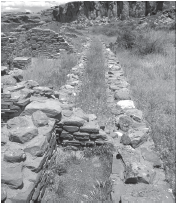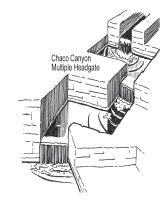| Many Oasis America water features and basins have perplexed archaeologists for years. From Mummy Lake, Colorado to Wupatki and Casa Grande, Arizona, to the extensive lakes and wells of Paquimé, these water features have remained an enduring mystery as they collect very little water of questionable hygienic quality. Thousands of these artificially constructed water and organic debris catchment basins dot the landscape from the Hohokam and Anasazi in the north to the Aztec and Maya in the south. Our unique proposal is that these items represent a well-planned and constructed system of fertilizer dehydration basins for the production of fertile sediment to grow corn. I also propose that these were specifically designed to catch monsoonal rainfall that was chemically altered by lightning, splitting nitrogen into nitrates that are usable by plants. Organic plant material, charcoal, human and animal waste, and blue/green algae were added to the nitrate rich water to produce, under the hot summer sun, an organic gray water solution that was used to fertilize the corn at the specific C4 genetic growth spurt characteristic inherent in the corn maturation cycle. In most known cases, there are a large number of pot shards reportedly associated with water transport ceramics near these features. These specific utensils were items of high religious significance and were used to apply the fertile water to the dike fields associated with the water features (Scarborough, Wilcox, Wilshusen). Hohokam and some Paquimé “ballcourts” have topographically depressed centers and raised oval sides. The floors were also sealed with caliche or other material so that they would hold water. Our proposition is, if the Hohokam and Paquimé people built them to collect and hold water, that was their intended use. There is one known confirmed example of a ballcourt at Paquimé. As the concept of rainwater to fertilizer dehydration basins has never been proposed, anything that remotely resembles an elongated or oval shape, is today, being, I believe incorrectly, identified as a “ballcourt.” The fact that the Chetro Ketl field is layered with clay, or even plastered, indicates from context of sealed shallow basins across Oasis America that this is the most efficient, ingenious and grand scale fertilizer dehydration basin field yet found in the region. As one might expect from other Chacoan examples , the engineering and design of this fertilizer production technology would be the most advanced north of Paquimé. One might ask how I, as a research and, in this case, forensic journalist, came upon the story that resolved the Chaco mystery. It is really quite simple. A decade ago, while delivering over 150 tons of famine relief corn to the Tarahumara Indians of Copper Canyon Mexico, one of the tribal elders told me, “Most important thing fertilizer, then rain, and finally control of root cut worm. With those things provided by god, we don’t need food aid.” Today, the Tarahumaras are the only aboriginal people left in this region who have to raise their own food to survive. |
Other indigenous as well as migrants into this region are at least three generations removed from any type of serious productive agriculture. The ancient knowledge of Anasazi, Hohokam, and Paquimé sophisticated agricultural technologies have been lost to the body of human knowledge, until now. When that ancient Tarahumara elder spoke, I listened and remembered. I realized following the Tarahumara life-style that the Chacoans used transhumance to gain access to the highlands surrounding the San Juan basin to exploit higher rainfall, more fertile soils, and be near the hard freeze line to control root cut worm and other pests. My very last “discovery” in solving the fertilizer riddle came after this paper was officially finished. I must confess that the Chacoans were so sophisticated that I was completely stumped in finding how they made the most important thing, fertilizer. As I completed hundreds of interviews in bringing the agricultural foundation for these ancient cultures to light, archaeologists often reminded me “remember they were agriculturalists first. No food, no culture.” I listened and remembered. Where this basic rule of survival lead me, I am sure will be as big a surprise to archaeologists as it was to me. For example, I had no intention of approaching “grid gardens” of Chaco as they seemed a very plausible and even likely agricultural strategy. I scanned that report at the very last moment before publication to make sure all of my “T’s” were crossed and “I’s” dotted. It shocked me when I found that in the very best case scenario that those gardens would only feed an estimated 82 people and were plastered over, of all things. Perhaps a few romantics may be disappointed in the loss of Hohokam ballcourts, Chacoan grid gardens, and Paquimé ceremonial reservoirs. For me, the analogy that seems appropriate is the experience putting together a complex machine engineered in Japan from an instruction booklet. While one is working at construction, the impulse to smash the entire thing must be carefully resisted because when the project is finished, one can stand back and be awed by the genius of the Japanese. I now have this same experience with the Chaco Canyon Anasazi. Simply put, how did they understand their natural world so well that they applied technologies and practiced life-styles that has defied modern science for over a century? As the archaeologists frequently reminded me, “remember they were agriculturalists first” and fertilizer, according to the Tarahumara, is the “most important thing” in agriculture. |
||||||
 |
Often called the Chetro Ketl “mote,” I propose that this structure along the south wall was a channel for the collection of human waste materials. Waste being used for fertilizer is one of the foundations of agriculture worldwide including “motes” found at European castles as well as in Mayan and Chinese cities during this era. No provision for this necessary deposit has been made at Chaco. |  |
The three tiered Chaco Canyon multiple headgate design can be used for adding waste material to irrigation water to produce soluble nitrates for the field of fertilizer dehydration basins. This closely resembles the “gate and pool” system found at Lefthand Canyon by Prof. Neely. Contrasting this observation, R. Gwenn Vivian proposed that the three boxes were built at different time periods as canyon terrace levels changed. |
||||
copyright 2005 - Richard D Fisher - DigitalTeamWorks.com